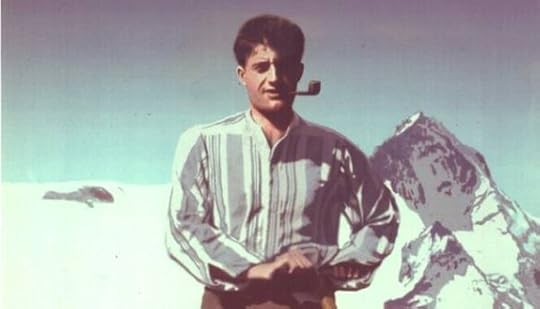Brandon Vogt's Blog, page 3
December 26, 2017
How to Easily Read the Whole Bible in 2018
As you prepare for the new year, why not commit to reading the entire Bible in 2018? It’s not as hard as you might think.
The Bible contains around 775,000 words. The average adult reads 250 words per minute. That means if you read the Bible for just 10 minutes per day, you’ll get through the whole thing in a year!
Everyone can find 10 minutes in their day, whether early in the morning, during a lunch break, or before going to bed.
But after committing to reading the whole Bible, most people have two questions: which translation should I use, and how should I do it?
Which Translation to Use?
There are a few things to keep in mind with translations. First, make sure your Bible is complete. Protestant translations such as the New International Version (NIV), the English Standard Version (ESV), and the King James Version (KJV) do not contain the seven deuterocanonical books that the Catholic Church accepts as Sacred Scripture. You’re going to want those books in your Bible (they’re really good!) so get a Catholic Church-approved translation.
Second, you want to make sure your Bible translation strikes a good balance between precision and readability. Avoid paraphrase translations, such as The Message. Instead, go with a more literal (i.e., “word for word”) translation that is still easy to read. Here are my personal recommendations, in order of preference. All of them have been officially approved by the Catholic Church for personal study:
Revised Standard Version – 2nd Catholic Edition (RSV-2CE) – This is the one I use, and it’s hailed by most Catholic Bible scholars I know. It offers a literal but still very readable translation.
New American Bible – Revised Edition (NAB-RE) – This is the translation used during the Mass, although it does contain some questionably translated passages and some dubious footnotes. But if you want to sync your reading to the liturgy, this is your best choice.
New Revised Standard Version (NRSV) – Solid translation although it contains gender inclusive language, changing “brothers” to either “friends” or “brothers and sisters.”
Douay-Rheims Version (DR) – This was the standard Bible for English-speaking Catholics from 1609 until the twentieth century. It’s a trusted version but some readers find it a bit turgid, similar to the King James Version.
You might also check out study Bibles that are specifically designed for a one-year reading plan. For instance, there’s the My Daily Catholic Bible (NAB) which divides all of Scripture into 365 segments, one for each day of the year. It features two small readings for each day, one from the Old Testament and one from the New Testament, along with an insightful quote from a saint. The best part is that the readings are all grouped together sequentially so you don’t have to flip back and forth each day between the Old and New Testaments.
There’s also the Catholic One Year Bible which uses the Catholic Living Bible translation, a less-then-literal translation but one that many readers find breezier and more accessible.
In the end, what matters most is that you find a translation you’ll actually read. If you pick one that is cumbersome or inaccessible, then it doesn’t really matter whether it’s accurate. Your best bet is to sample a few translations online and then choose one you feel most comfortable reading each day.
What’s the Best Plan?
Similar to the translation question, the answer here is whichever plan you’ll follow. Unfortunately, many people figure they’ll just start with Genesis and plow right on through to Revelation. That’s a bad idea. As anyone who has tried this knows, some of the early Old Testament books are meticulous, such as Leviticus and Numbers, and most people get bogged down, wiping out before finishing even half the Old Testament.
What’s a better strategy? Follow a carefully designed reading plan that will serve you the right parts of Scripture, at the right pace and the right time. Some of these plans alternate between Old and New Testament readings, while some also intersperse the Psalms throughout the year to add variation.
Here are some of my favorite Bible reading plans for Catholics. Choose your Bible translation, then choose a plan, and you’ll be ready to make 2018 the year you finally finish the whole Bible:
Read the Bible and the Catechism in a Year – This plan, created by the Coming Home Network, is perhaps my favorite. Not only does it take you through the whole Bible (the Catholic Bible, including the deuterocanonical books), but it also gets you through the entire Catechism of the Catholic Church. Each day you read about three chapters of Scripture and fifteen paragraphs of the Catechism. It will take about 30 minutes each day, but then at the end of the year, you will have finished the Bible and the Catechism—you’ll know more about your faith than 99% of fellow Catholics. (Note: To get the PDF of this plan, you have to enter your email address, but it’s definitely worth it.)
Dr. Mary Healy’s Read the Bible in a Year Plan – This plan was created by Dr. Mary Healy, a premier Catholic biblical scholar, and it’s great because it has you reading excerpts from the Old Testament, Psalms, and New Testament each day. That means when you get to the difficult Old Testament sections, you’ll still have the Psalms and New Testament to balance you out.
CatholicBibleInAYear.org Reading Plan – This one is similar to Dr. Healy’s plan except it offers even more variety each day. You’ll read two Old Testament readings, one New Testament reading, and one psalm each day.
Pierced Hands Reading Plan – My friend Meg Hunter-Kilmer created this plan. As Meg explains, “This one still gets you through the whole Bible in a year (and the Gospels twice), but it goes chronologically through the Old Testament (more or less) with New Testament books and fun books like Ruth and Jonah interspersed throughout to mix things up. It also gives you a chapter of some poetic stuff every day instead of dragging you through Proverbs for 200+ days. This schedule is more user-friendly, more reasonable for those who haven’t read the Bible before, and can start any day of the year.” (Meg also has a really cool Bible timeline PDF that she recommends you print and keep tucked in your Bible.)
My Personal Solution
I mentioned above that I prefer the Revised Standard Version – 2nd Catholic Edition (RSV-2CE) for Scripture study. But I also have a secret weapon: the Verbum Bible software.
I’ve written before about how amazing this is, calling it the most powerful Bible resource ever available. But Verbum also makes it super easy to read the Bible in a year. It does so with a built-in reading plan, right out of the box:
The best part about using Verbum is that the reading plan syncs across all of your devices. So you can read the daily Bible passages on your computer, tablet, phone, or any other mobile device. It’s great for people like me who are constantly on the go and often forget to carry around a print version of the Bible. (Verbum also syncs your highlights and notes across all devices, so the reading experience is seamless.)
To be up front, though, the Verbum library packages can be pretty expensive—the cheapest base package is $236.
But if you’re just interested in reading the Bible, the Catechism, and basic Church documents, check out the Verbum Catechism of the Catholic Church Collection. It’s only $50 and gives you lifetime access to the powerful Verbum software along with the Revised Standard Version – Catholic Edition (RSV-CE) of the Bible, the Catechism of the Catholic Church, the lectionary (the readings used at Mass), the documents of Vatican II and the Council of Trent, and a few other resources. All of those documents can be accessed on the go, on any device you’re using. In my opinion, the cost of this collection ($50) is more than worth it if it enables you to finish the Bible in a year.
(I should note that the Catechism of the Catholic Church Collection does not come with all the features of the Verbum software. It lets you read the Catechism and Bible, create reading plans, notes, highlights, and a few other things. But if you want the complete set of powerful tools in Verbum, check out one of their library packages. With those you get the full power of the software along with tons of additional books, which really showcase the power of Verbum. I personally use Verbum Master and love tools like Clause Search and Bible Facts. If you use the code BVOGT at checkout, you’ll get 10% off any Verbum library—just not the Catechism collection.
Also, full disclosure, I get a small commission if you purchase one of the Verbum libraries, but nothing if you purchase the Catechism collection. Nevertheless, I still promote the Catechism collection because I think it’s a fantastic deal and the best way to get started with Verbum.)
So those are my tips and advice. Now a question:
Are you going to read the whole Bible in 2018?
Let us know in the comment box!
The post How to Easily Read the Whole Bible in 2018 appeared first on Brandon Vogt.





December 23, 2017
Learning from a Servant Who Endured Countless Trials

Today we continue our regular series called “Learning from the Saints.” Our guide is expert Bert Ghezzi, a dear friend of mine and the author of numerous books including Voices of the Saints, Saints at Heart, and Discover Christ: Developing a Personal Relationship with Jesus.
His more recent books are The Power of Daily Mass and The Heart of Catholicism. You can learn more about Bert and his work at BertGhezzi.com.
Today, Bert profiles St. Marguerite d’Youville, whose feast day is today. She is the patron of widows, difficult marriages, and the death of young children.
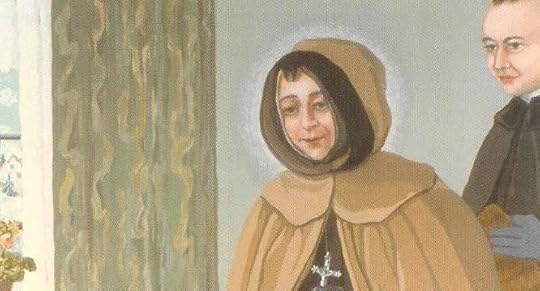
Name a trouble, and St. Marguerite d’Youville suffered it: her father’s early death, poverty, an unfaithful husband, a nasty mother-in-law, infant deaths, bankruptcy, fire, ridicule, persecution and more. Yet Marguerite seems joyfully to have trusted God to carry her through these terrible circumstances.
When Marguerite’s father died in 1714, she left school to help her mother support her family. At 21, she entered a disastrous arranged marriage with François d’Youville, a dashing but irresponsible young fur trader. He got Indians drunk and ripped them off, slept around and squandered the family fortune. On top of this, four of Marguerite’s six babies died. However, sometime in 1727 Marguerite had an extraordinary personal experience of God the Father’s love for her. That grace enabled her to endure François and his domineering mother without complaint, until his death in 1730 released her.
Marguerite devoted the rest of her life to caring for the poor. In 1737, she and three companions made a private commitment to serve the destitute. They rented a house as a place to welcome indigent boarders. When fire destroyed the building in 1745, Marguerite knelt in the ashes, prayed a thankful Te Deum and promised the poor she would never abandon them. Shortly after, she and her companions signed the “Original Commitment” which became the basis for her religious order. Here is an excerpt from the document:
“We, the undersigned, for the greater glory of God, the salvation of our souls and the relief of the poor, sincerely desiring to leave the world, renouncing everything we own to consecrate ourselves unreservedly to the service of the poor, have joined together in the bonds of the purest charity…. We have unanimously agreed and have freely promised…:
“To live together for the remainder of our lives in perfect union and charity, under the guidance of those superiors who will be given to us, in the practice and faithful observance of the rule prescribed for us;… in poverty and complete renunciation,… placing everything we now own and will own in common, not retaining ownership nor any right to dispose of it, making a pure, simple and irrevocable gift of it to the poor by this document….
“To devote unreservedly our time, our days, our effort, our life itself to work, and, putting the income in common, to provide for the support and maintenance of the poor.
“To shelter, feed and support as many poor people as we can either by our own means or by the alms of the faithful.
“All those who will be taken into the house will bring everything they own with them—linens, clothing, furniture and silver, to put everything in common not excepting or retaining anything, renouncing all rights of ownership and of retention, by the voluntary and irrevocable gift they will make of it to the members of Jesus Christ….”
So, Marguerite began to formalize her little band of associates into a religious community. In 1755 the bishop of Quebec approved the congregation as the Sisters of Charity. They adopted a grey habit and so were called the Grey Sisters. Because drunks often flopped on their doorsteps, persecutors mockingly tagged them “the tipsy sisters,” as the French word gris could mean “drunk” as well as “grey.” After Marguerite’s death in 1771, the Grey Sisters extended her ministry throughout the world, especially to the Inuit people of North America.
Sometimes we hold to the dumb idea that when God puts his hand on us everything will move forward with ease. The life experience of saints like Marguerite d’Youville should dispel that false notion once for all.
Read more from Bert at his website www.BertGhezzi.com, or check out his many books on Amazon.
The post Learning from a Servant Who Endured Countless Trials appeared first on Brandon Vogt.





November 28, 2017
Learning from a Model of Fruitful Obedience

Today we continue our regular series called “Learning from the Saints.” Our guide is expert Bert Ghezzi, a dear friend of mine and the author of numerous books including Voices of the Saints, Saints at Heart, and Discover Christ: Developing a Personal Relationship with Jesus.
His more recent books are The Power of Daily Mass and The Heart of Catholicism. You can learn more about Bert and his work at BertGhezzi.com.
Today, Bert profiles St. Joseph Pignatelli, whose feast day is today.

I am ambivalent toward obedience. Maybe you are, too. I have always liked obedience when my children did what they were told. But I often find the virtue prickly and hard-to-take when I am expected to obey. But obedience even in the worst circumstances may bear good fruit, as the life of Joseph Pignatelli demonstrates.
Shortly after Joseph Pignatelli was ordained as a Jesuit priest, Charles III expelled the society from Spain. With the community already repressed in Portugal and France, some Jesuits found temporary refuge in Corsica, until the French drove them out. Pignatelli helped to arrange a center for them at Ferrara.
In 1773, Pope Clement XIV yielded to political pressure and suppressed the Jesuits entirely. When the vicar general of the order asked the men at Ferrara whether they would obey, they said, “yes, willingly.” The result was to secularize Father Pignatelli and 23,000 other religious.
For twenty years, Fr. Pignatelli devoted himself to study and aiding other Jesuits. However, in the 1790s the tide began to turn. The Duke of Parma invited three Jesuits to establish themselves there. With the pope’s permission, Pignatelli established a novitiate at Colorno, sending men for training to Russia, where the government had not promulgated the suppression. After 1804, under the most difficult conditions, Pignatelli became provincial for Naples. Then, after the French drove out the Jesuits from Naples, provincial at Rome for all Italy.
In these very straightened circumstances, Pignatelli apparently had the help of divine intervention. Miracles seemed to accompany him, like the following described by an archbishop during his canonization process:
“I called at St. Pantaleon’s to confer with the provincial on business. I was seated at the side of his small desk, with not more than a foot between us. The procurator came in and said he needed immediately a certain sum of money. The provincial opened the top desk drawer where I saw right under my eyes a loose assortment of money. He gave the procurator the entire amount, which left the drawer empty.
“The procurator came right back, saying that he was still short of funds. I wish to emphasize the position I was in at the time. I was as close to the desk drawer as he was himself. My view of the interior was unobstructed. Then I witnessed a prodigy that I shall never forget. The saint paused momentarily. He seemed to withdraw from us, entering into himself and forgetting our presence.
“After a brief thought, he raised his eyes upward and moved his lips. I shall always remember the serene smile that lighted his face at that moment. Had he been in communion with the Invisible? I don’t know. But I watched him open the drawer he had just emptied. There in the identical location as before was, for all appearances, the same money he had already given to the procurator. The thing was so manifestly supernatural and I was so struck with wonder, that I cried out: ‘A miracle!’ At my shout, the holy man humbly bowed his head. The he abruptly turned to the subject of our interrupted conference.”
During the French occupation of Italy in the first decade of the 1800s, Fr. Pignatelli worked quietly to conserve the reorganization of the Jesuits he had achieved. He deserves recognition as the restorer of the Jesuits, even though the full restoration of the society did not occur until 1814, three years after his death. Pope Pius XII canonized him in 1954.
“The cross represents the inversion of all human values. The human is put to death and out of the death comes life.”
— John Courtney Murray
Read more from Bert at his website www.BertGhezzi.com, or check out his many books on Amazon.
The post Learning from a Model of Fruitful Obedience appeared first on Brandon Vogt.





November 9, 2017
Book Giveaway (3 copies): “The Case for Catholicism” by Trent Horn
“Find out how much God has given you and from it take what you need; the remainder is needed by others.” — St. Augustine
Since I’ve built up a large collection of extra books and resources, every week I give some away absolutely free, no strings attached. Each giveaway lasts seven days with a new one beginning every Friday. You can enter any time during the week. Check out my past giveaways here.
Today I’m giving away THREE copies of an exciting new book by Trent Horn, titled The Case for Catholicism: Answers to Classic and Contemporary Protestant Objections. Learn more and enter below!
The Case for Catholicism: Answers to Classic and Contemporary Protestant Objections
by Trent Horn
Ignatius Press, 342 pages, paperback
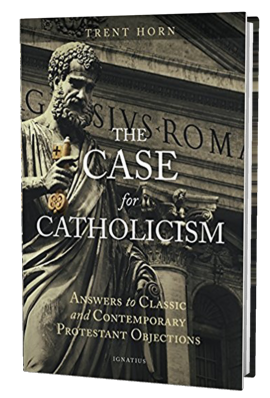 This is the most up-to-date, comprehensive, and thorough defense of the Catholic Church against Protestant objections in print. This book is especially relevant as the 500th anniversary of the Protestant Reformation draws near and discussion of the arguments made against the Church during that time in history receive renewed interest.
This is the most up-to-date, comprehensive, and thorough defense of the Catholic Church against Protestant objections in print. This book is especially relevant as the 500th anniversary of the Protestant Reformation draws near and discussion of the arguments made against the Church during that time in history receive renewed interest.
The Case for Catholicism answers arguments put forward by early Reformers like Luther and Calvin as well as contemporary defenders of Protestantism like Norm Geisler and R.C. Sproul. It provides a meticulous defense of the biblical and historical nature of Catholic doctrines from Scripture and church history.
Finally, in both answering Protestant objections to Catholicism and in providing evidence for the Faith, The Case for Catholicism cites modern Protestant scholars who question Reformation assumptions and show how evidence from Scripture and church history support aspects of Catholic theology.
This book is divided into four sections, with each answering a key question Christians have asked about the nature of their faith. Those key questions are:
– What is my authority?
– What is the Church?
– How am I saved?
– Who belongs to the body of Christ?
The Case for Catholicism will become a reliable, resource for any Catholic who desires a well-researched, readable, and persuasive answer to Protestant arguments made against the Catholic faith.
I’m using Gleam to help with the giveaway, which is cool because it allows you multiple entries for posting on Facebook, sharing on Twitter, etc. Click below to enter:
(If you’re reading this through email or RSS and don’t see the giveaway widget, click here.)
By entering this giveaway you agree to occasionally receive email updates from me—no spam, just updates about free books, cool links, and exciting news.
The post Book Giveaway (3 copies): “The Case for Catholicism” by Trent Horn appeared first on Brandon Vogt.





October 3, 2017
Learning from a Missionary Who Never Left Her Convent

Today we continue our regular series called “Learning from the Saints.” Our guide is expert Bert Ghezzi, a dear friend of mine and the author of numerous books including Voices of the Saints, Saints at Heart, and Discover Christ: Developing a Personal Relationship with Jesus.
His more recent books are The Power of Daily Mass and The Heart of Catholicism. You can learn more about Bert and his work at BertGhezzi.com.
Today, Bert profiles St. Thérèse of Lisieux, the Little Flower who is the patroness of foreign missions, and whose feast day is today.
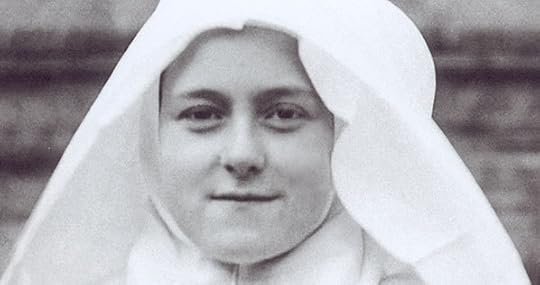
From obscurity as a young, idealistic Carmelite, Thérèse of Lisieux has emerged as one of the best loved saints. Her simplicity attracts us because she puts holiness within our reach.
Thérèse was the daughter of Louis and Zélie Martin. When she was four years old, her pleasant childhood was interrupted by Zélie’s untimely death. Then Thérèse’s older sister, Pauline, took responsibility for raising her in the faith. In 1882, Pauline entered the Carmelite convent at Lisieux, igniting a desire in Thérèse to do the same.
Thérèse’s fourteenth year was pivotal. Her sister, Mary, joined Pauline at the convent. And at Christmas, the young saint had an experience she described as her “conversion.” Later, in A Story of a Soul, her Autobiography, Thérèse described it as a release from depression and oversensitivity:
“Jesus flooded the darkness of my soul with torrents of light. I got back for good the strength of soul lost when I was four and a half. Love filled my heart, I forgot myself, and henceforth I was happy.”
In spite of Thérèse’s youth, the next year the bishop allowed her to become a Carmelite at Lisieux.
From childhood, Thérèse aspired to become a missionary and a martyr. It soon became clear to her, however, that neither option was open to a cloistered nun. So she sought the Holy Spirit and searched the Scripture for another way to excel:
“We live in an age of inventions. We need no longer climb laboriously up flights of stairs. And I am determined to find an elevator to carry me to Jesus, for I was too small to climb the steep stairs of perfection. So I sought in Holy Scripture some idea of what this lift I wanted would be, and I read, ‘Whoever is a little one, let him come to me’ (See Lk 8:16). I also wanted to know how God would deal with a ‘little one,’ so I searched and found: ‘You shall be carried in her arms and fondled in her lap; as a mother comforts her son…’ (Is 66:12-13; NAB)
“It is your arms, Jesus, which are the elevator to carry me to heaven. So there is no need for me to grow up. In fact: just the opposite: I must become less and less.”
In 1897, Thérèse thought her dream of becoming a missionary was about to come true. The Carmelites at Hanoi in Indo-China had invited her to join them. But on the early morning of Good Friday, she began to hemorrhage from the mouth. She had contracted tuberculosis, which tortured her for several months before it took her life on September 30, 1897.
Thérèse learned to do the loving thing in every situation, which she discovered was the fuel that fired the faith of martyrs and saints. That was the secret of her “little way” of perfection that has captivated our hearts:
“Great deeds are forbidden me. I cannot preach the gospel nor shed my blood—but what does it matter? My brothers toil instead of me and I, a little child keep close by the throne of God and I love for those who fight. Love proves itself by deeds. I will scatter flowers, perfuming the Divine Throne, and I’ll sweetly sing my hymn of love. These flowers are every little sacrifice, every glance and word, and the doing of the least of actions for love.”
Read more from Bert at his website www.BertGhezzi.com, or check out his many books on Amazon.
The post Learning from a Missionary Who Never Left Her Convent appeared first on Brandon Vogt.





September 11, 2017
Learning from a Martyred Missionary Disciple

Today we continue our regular series called “Learning from the Saints.” Our guide is expert Bert Ghezzi, a dear friend of mine and the author of numerous books including Voices of the Saints, Saints at Heart, and Discover Christ: Developing a Personal Relationship with Jesus.
His more recent books are The Power of Daily Mass and The Heart of Catholicism. You can learn more about Bert and his work at BertGhezzi.com.
Today, Bert profiles St. John Gabriel Perboyre, a French priest who served as a missionary in China, whose feast day is today.
“O my Divine Savior,
transform me into yourself,
May my hands be the hands of Jesus.
May my tongue be the tongue of Jesus.
Grant that every faculty of my body
may serve only to glorify you.
Above all transform my soul and all its powers
that my memory, my will and my affections
may be the memory, the will and the affections of Jesus.
I pray you to destroy in me all that is not of you.
Grant that I may live
but in you
and by you
and for you
that I may truly say with Saint Paul:
“I live now, not I, but Christ lives in me.”
— John Gabriel Perboyre
 “I mean to be a missioner!” announced 15-year-old John Gabriel Perboyre after hearing a sermon on foreign missions. From that time his determination grew firm and specific. John Gabriel believed God was calling him to take the gospel to China. One year later, in 1818, he joined the Congregation of the Mission, the Lazarists, and entered their seminary at Montauban, France.
“I mean to be a missioner!” announced 15-year-old John Gabriel Perboyre after hearing a sermon on foreign missions. From that time his determination grew firm and specific. John Gabriel believed God was calling him to take the gospel to China. One year later, in 1818, he joined the Congregation of the Mission, the Lazarists, and entered their seminary at Montauban, France.
John Gabriel was ordained a priest in 1826, chomping at the bits to be sent on mission. However, because he was an excellent teacher, the Lazarists deployed him as a seminary professor at Saint-Flour and trainer of novices in Paris. Finally after nine years of pleading, in 1835 John Gabriel was sent to the China mission.
The saint was a quick study. After four months of training in China, he could speak enough of the language to be sent to the mission station at Honan. “If you could see me now in my Chinese ‘get up,’ he wrote to his brothers at Paris,
“you would see a very curious sight: my head shaved, a long pig-tail and moustaches, stammering my new language, eating with chopsticks. They tell me that I don’t make a bad Chinese. That is the only way to begin making oneself all things to all men: may we be able thus to win all men to Jesus Christ!”
For two years at Honan, John Gabriel rescued street children and taught them the faith with engaging stories in his colloquial Chinese. In 1839, he was sent to teach catechumens at Hupeh, where a persecution unexpectedly erupted. John Gabriel hid in a nearby forest, but was betrayed by a new convert and was captured.
For the next year John Gabriel Perboyre patiently endured the unendurable. He was dragged in chains before judges who demanded that he inform on his associates and stomp on the crucifix. Twenty times he was confronted. Twenty times he refused. And twenty times he was brutally tortured. Once he was branded on his face with four characters that proclaimed he was “a teacher of false religion.” Near the end his body was a mass of open wounds with bones exposed.
John Gabriel wrote his prayer for Christlikeness, quoted above, when he was twenty-three years old, and prayed it often.. The answer seems to have been yes both in his life and in his death. At last on September 11, 1840, John Gabriel was strangled along with five criminals, a martyrdom fitting for a saint who wanted so much to be like Jesus.
“Many people have difficulty in finding a meditation book. But I have found nothing so good as my own heart and the heart of Jesus. Why is it that we so often change the subject of our meditation? Only one thing is necessary: Jesus Christ. Think unceasingly of him.”
—St. John Gabriel Perboyre
Read more from Bert at his website www.BertGhezzi.com, or check out his many books on Amazon.
The post Learning from a Martyred Missionary Disciple appeared first on Brandon Vogt.





August 24, 2017
Watch My FREE New Video Series on the “Best Evidence for God”!
I couldn’t believe the statistic when I heard it:
In the past ten years, the number of atheists has DOUBLED in America.
Can you believe that?? DOUBLED. It’s crazy!
Increasingly, people are leaving religion, questioning the Bible, and doubting God.
And these are people we love: our family, friends, coworkers, and neighbors. Yet these are people who are really struggling to believe in God.
So what can you do? What can you say?
How can you show them that God is real?
This is really hard for many Catholics.
All Catholics know God exists, but it’s difficult to show that God exists. (See the difference?)
That’s why I created a FREE new video series for you, called “Best Evidence for God”:
https://BestEvidenceForGod.com
I think you’re going to love it!
You’ll not only understand the rise of atheism, but more importantly you’ll learn how to help skeptical friends and family see that God is real.
The free series includes four videos, and Video #1 just went live today.
Today, in Video #1, you’ll learn:
– Why the rise of atheism and skepticism is such a BIG problem
– Key facts about atheism that you need to know
– What I’ve learned from THOUSANDS of conversations with atheists
So just click here to watch Video #1 in my FREE new video series:
Watch Video #1—> The Shocking Rise of Atheism
The journey begins today!
PS. Don’t forget to leave a comment under the video! I read every single one of them and respond to as many as I can.
PPS. Can you help share this around? I want to help as many Catholics as possible with their doubting loved ones. Just share this link on Facebook, Twitter, or through email: https://BestEvidenceForGod.com
The post Watch My FREE New Video Series on the “Best Evidence for God”! appeared first on Brandon Vogt.





August 11, 2017
Learning from a Saint Who Mirrored Christ and St. Francis

Today we continue our regular series called “Learning from the Saints.” Our guide is expert Bert Ghezzi, a dear friend of mine and the author of numerous books including Voices of the Saints, Saints at Heart, and Discover Christ: Developing a Personal Relationship with Jesus.
His more recent books are The Power of Daily Mass and The Heart of Catholicism. You can learn more about Bert and his work at BertGhezzi.com.
Today, Bert profiles St. Clare of Assisi, the patron of television, eye disease, embroiderers, and good weather, whose feast day is today.
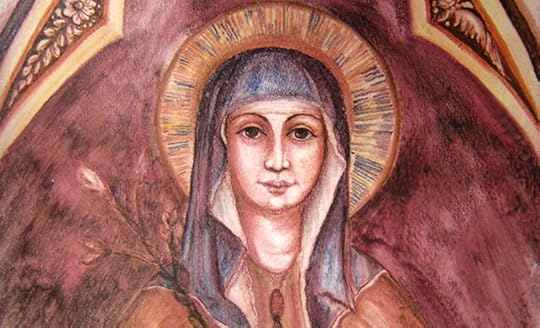
Clare was already a faithful Christian when she first met St. Francis of Assisi in 1211, but his total dedication to Christ sealed her convictions. Clare decided that she also wanted to live by the gospel as simply as possible.
She determined compare herself to Jesus as though looking in a mirror. She expected to conform her behavior to his image, and she taught others to do the same. For example, she exhorted Queen Agnes of Bohemia to look at herself in Christ-the-mirror:
“Happy the soul to whom it is give to attain this life with Christ, to cleave with all one’s heart to him whose beauty all the heavenly hosts behold forever;
whose love inflames our love;
whose contemplation is our refreshment;
whose graciousness is our delight;
whose gentleness fills us to overflowing;
whose remembrance gives sweet light;
whose fragrance revives the dead;
whose glorious vision will be the happiness of all the citizens of that heavenly Jerusalem.
For he is the brightness of eternal glory (see Heb 1:3), the splendor of eternal light, the mirror without spot (see Wis 7:26).
Look into that mirror daily, O queen and spouse of Jesus Christ. Always study your face in it, so that within and without you may adorn and clothe and gird yourself with all manner of virtue. So by God’s grace you can contemplate blessed poverty, holy humility and sacred charity, which are reflected in that mirror.”
Francis invited Clare to lead a community of women who would live like his friars. On Palm Sunday, 1212, Clare met him and his brothers at a chapel where she committed herself to live by the gospel in poverty and chastity. Clare’s family was outraged because they felt she had disgraced them. Relatives even tried to bring her home forcibly, but she held firm. In a short time things calmed down, and many prominent women of Assisi, including her sister and mother, joined her.
Francis gave Clare a house near the church of San Damiano outside the walls of Assisi. There she and her sisters happily followed a severe pattern of life. The women wore rough habits, went barefoot, fasted often, slept on the floor, abstained from meat entirely and spoke only when necessary.
Like Francis, Clare was determined to imitate Christ’s poverty. She wanted her sisters to own nothing and live on daily contributions. “O blessed poverty!” she wrote to her friend Queen Agnes:
“To those who love and embrace her she gives eternal riches. O holy poverty! to those who possess and desire her, God promises the kingdom of heaven and bestows eternal glory and the blessed life. O poverty whom the Lord Jesus Christ deigned to embrace so completely!
“Rejoice and be glad that so great and good a Lord, on coming into the Virgin’s womb willed to appear despised, needy and poor in this world, so that men who were in dire poverty and suffering great need of heavenly food might be made rich in him.”
Within a few years, convents of Clare’s followers popped up in Italy, France and Bohemia. Clare seems to have had a gift of healing which blessed her sisters and neighbors. But she herself was ill for 27 years before she died in 1253.
Read more from Bert at his website www.BertGhezzi.com, or check out his many books on Amazon.
The post Learning from a Saint Who Mirrored Christ and St. Francis appeared first on Brandon Vogt.





July 14, 2017
Learning from a Giant Saint Who Could Have Been in the NBA

Today we continue our regular series called “Learning from the Saints.” Our guide is expert Bert Ghezzi, a dear friend of mine and the author of numerous books including Voices of the Saints, Saints at Heart, and Discover Christ: Developing a Personal Relationship with Jesus.
His more recent books are The Power of Daily Mass and The Heart of Catholicism. You can learn more about Bert and his work at BertGhezzi.com.
Today, Bert profiles St. Camillus de Lellis, the patron of nurses and the sick, whose feast day is today.
St. Camillus was a giant for his times, standing 6 feet, 6 inches tall. He also became a spiritual giant through his unselfish service of the sick.
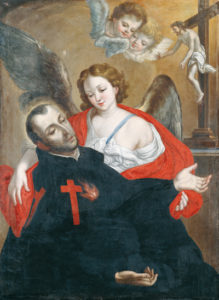 At 17, Camillus went with his father to fight against the Turks, and while at war his leg became infected with a serious disease that remained with him for life. He was a rebellious youth, with an addiction to gambling that nearly destroyed him. By age 24 he had literally lost his shirt to gambling. At 25, however, while working at a Capuchin monastery, he responded to a friar’s preaching with radical repentance. He turned his life to Christ and wanted to become a Capuchin, but could not be admitted to the order because of his diseased leg. So he went to work at a hospital for the incurably sick in Rome where he had spent some time when his leg was first infected. There he devoted himself entirely to the care of the sick. The hospital administrators were so impressed with his charity and ability that they appointed him bursar. And to prepare himself to assist the sick spiritually he became a priest.
At 17, Camillus went with his father to fight against the Turks, and while at war his leg became infected with a serious disease that remained with him for life. He was a rebellious youth, with an addiction to gambling that nearly destroyed him. By age 24 he had literally lost his shirt to gambling. At 25, however, while working at a Capuchin monastery, he responded to a friar’s preaching with radical repentance. He turned his life to Christ and wanted to become a Capuchin, but could not be admitted to the order because of his diseased leg. So he went to work at a hospital for the incurably sick in Rome where he had spent some time when his leg was first infected. There he devoted himself entirely to the care of the sick. The hospital administrators were so impressed with his charity and ability that they appointed him bursar. And to prepare himself to assist the sick spiritually he became a priest.
Camillus was appalled by conditions at the hospital and began to surround himself with other young men who were committed to serve the sick. With the support of his adviser, St. Philip Neri, he founded in 1585 the Servants of the Sick, a congregation of male nurses. They pledged themselves to care for the plague-ridden, the sick in hospitals and at home and prisoners. Camillus and his brothers founded and staffed eight hospitals in Italy. In 1595 and 1601 some of them attended the wounded on battlefields in Hungary and Croatia, the first recorded examples of military ambulance units.
Sick and in pain most of the time Camillus himself served without complaint. A member of his order wrote this moving description of the saint:
“I cannot get it out my mind, that when he was attending on a sick person, he looked like a hen with her chickens or like a mother at the bedside of her sick child. For, as if his arms and hands were not enough for the expressions of his affection, he might generally be seen bent over the poor man, as though he wished to communicate to him his heart, his breath, and his very soul.
“Before leaving the bed, too, he would keep smoothing the pillow and gently removing the bedclothes from the sick man’s face and feet and sides. And as if attracted by some invisible lodestone, he seemed as though he could not force himself away. But he hovered about the bed, inquiring how the patient felt, whether he wanted anything else, and giving him some maxim to meditate on for the good of his soul.
“I know not what more the most affectionate mother could have done for her only child in his sickness. No one who did not know the holy father would ever have thought that he had gone to the hospital to serve all the sick without distinction. They would have supposed that all his care was wrapped up in the life of that one poor man and that he had nothing else in the world to think about.”
Camillus championed some avant-garde medical practices, insisting, for example, on proper diet, fresh air and isolation of infected patients. He died in 1614.
Read more from Bert at his website www.BertGhezzi.com, or check out his many books on Amazon.
The post Learning from a Giant Saint Who Could Have Been in the NBA appeared first on Brandon Vogt.





July 4, 2017
Pier Giorgio Frassati, Man of the Beatitudes: An Interview with Archbishop Peter Sartain
I recently had dinner with Archbishop Peter Sartain, the affable leader of Seattle’s Catholic community. Quickly I learned why so many churchman admire him. After an exchange of greetings, the first thing he did was hand me a second-class relic of Bl. Pier Giorgio Frassati, my favorite saint. That launched a long conversation about the man Pope John Paul II christened “the man of the beatitudes,” to whom I and Archbishop Sartain both have a strong devotion.
Through dinner I learned that Archbishop Sartain is one of the world’s leading Pier Giorgio experts. He has read almost all the relevant literature, in both English and Italian, and is close friends with Pier Giorgio’s surviving family. The archbishop also frequents Turin, Italy, where Pier Giorgio lived and died.
On this his feast day, the fourth of July, Archbishop Sartain agreed to chat with me more about Pier Giorgio’s impact, his love for the poor, and some recommended books on the young saint.
BRANDON VOGT: What first drew you to Pier Giorgio Frassati and how has he impacted your life?
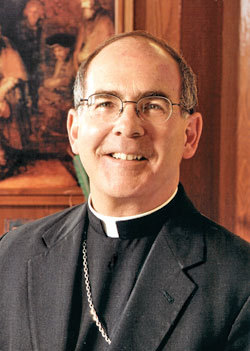 ARCHBISHOP SARTAIN: I was first introduced to Pier Giorgio when I was a seminarian in Rome in the mid-1970’s. The quickest route from the seminary to St. Peter’s Basilica took you along the Via Pfeiffer, on which the 12th century church, San Lorenzo in Piscibus, is located. The church is named “in Piscibus” because many years ago the fish market was nearby!
ARCHBISHOP SARTAIN: I was first introduced to Pier Giorgio when I was a seminarian in Rome in the mid-1970’s. The quickest route from the seminary to St. Peter’s Basilica took you along the Via Pfeiffer, on which the 12th century church, San Lorenzo in Piscibus, is located. The church is named “in Piscibus” because many years ago the fish market was nearby!
I passed that way frequently, but the church was always locked. One day, however, I found it open and noticed that many young adults my own age were going inside, so I followed them. It turned out that the church was hosting an exhibition on the life of Pier Giorgio, who at that time had not yet been beatified. I was impressed and inspired by his story, told in words and pictures in the beautiful exhibit. As a young man about his age, I was moved by his extraordinary life, and how at such a young age he integrated his deep love for God, a profound life of prayer, an active life of sports, leadership in various Catholic groups, his love and service of the poor, and his treasuring of good friendships.
I remember leaving the church and going immediately to a nearby bookstore to buy as many books as I could about his life. The more I got to know him, the more I wanted to imitate him, and the more I wanted to tell others about him.
After I was ordained and returned to the States, I kept up with the cause for his canonization, and during several return trips to Rome I discovered some interesting magazine articles about the progress of his cause. As a young priest, I found many things in his life to imitate and knew that young people would find him to be a great example. When I was pastor of St. Louis Church in Memphis, I inaugurated a “Frassati Society” in response to a group of young adults who approached me about creating new outreach to their generation. The Frassati Society was a great success—we met every Sunday evening. We spent time in prayer, always had some catechetical input, enjoyed some social time, planned service projects and retreats—and always ended our evening with prayer before the Blessed Sacrament in Church.
Since my first encounter with Pier Giorgio in the mid-70’s, I have thought of him as a friend, and he continues to be an example and important intercessor for me. I still enjoy telling his story to anyone who will listen!
BRANDON VOGT: Pier Giorgio’s life was full of wonderful anecdotes. Which is your favorite?
ARCHBISHOP SARTAIN: There are many favorites! One occurred just four nights before he died. He had been reading Johannes Jorgensen’s recently-published Life of St. Catherine of Siena. Frassati was already ill with the acute case of poliomyelitis that would soon cause his death, though he did not know it, and during a visit with two close friends, he excitedly read passages from the book. One passage recounted the day that St. Catherine, praying the Office as she walked back and forth inside a church, had the sense that someone was walking with her—and realized it was Jesus! Here’s what Jorgensen writes:
“Like two young ecclesiastics saying their office together, the Saviour and Catherine walked up and down the brick floor of the chapel…and when, at the end of each psalm, she had to say the doxology: “Glory be to the Father and to the Son,” etc., she altered the words and making a deep reverence towards the Lord, said in a trembling voice: “Glory be to the Father and to Thee and to the Holy Ghost. As it was in the beginning, is now and ever shall be, world without end, Amen.”
Pier Giorgio was understandably captivated by Catherine’s closeness to Christ and the fact that Christ showed himself so clearly to her. After a moment of silence, he turned to his friend Massetti and, with a seriousness that perplexed his friend, said, “See, St. Catherine already had in life the gift of seeing Jesus.” And after another pause, he added, “but we have to wait until we go to Paradise.”
I love that passage myself, because it showed how much he longed to see Jesus—how Jesus for him was Everything—and how he was about to be called to eternal life by Jesus, in just four days.
BRANDON VOGT: Like all saints, Pier Giorgio understood the deep congruence between the corporal and spiritual works of mercy. How did his faith and his charity flow into each other?
ARCHBISHOP SARTAIN: You’re right. I don’t think Pier Giorgio made any distinctions in his life between faith, prayer, mountain climbing, friendships, and active love—for him, they were all of a piece, all a part of being a disciple of Jesus.
Most of all, he could not conceive of a life that did not include faith and deep prayer. He loved the poor intensely and saw Jesus in them—from prayer Jesus sent Pier Giorgio to them, and in them he met Jesus. This kind of spiritual maturity was extraordinary—it’s something I aspire to.
BRANDON VOGT: Pier Giorgio’s cause for canonization hit a few early snags when people chafed at his pipe smoking and partying. What should we make of these activities?
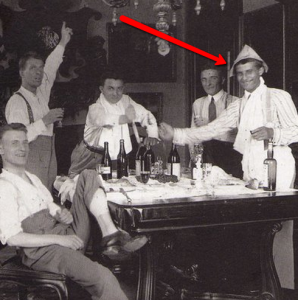 ARCHBISHOP SARTAIN: Honestly, I don’t think we should make anything of them other than see in them a young man like us who led a full life and made his spiritual life the integrating factor of everything.
ARCHBISHOP SARTAIN: Honestly, I don’t think we should make anything of them other than see in them a young man like us who led a full life and made his spiritual life the integrating factor of everything.
As for “partying,” he knew how to enjoy life and desired to help others enjoy life, too. We have to be leery of thinking of his “partying” in 21st century terms. Here we’re talking about the way he enjoyed social time with his friends. He was a jokester and wanted others to enjoy themselves. He wanted to encourage their friendship because he knew that true, faith-filled friendship is a gift of God. He also knew that joy is a sure sign of a person in love with God.
BRANDON VOGT: On May 20, 1990, Pope John Paul II beatified Pier Giorgio and described him as “a man of the beatitudes.” Why this title?
ARCHBISHOP SARTAIN: During his homily on that occasion, Blessed John Paul said:
“Entirely immersed in the mystery of God and totally dedicated to the constant service of his neighbor, he is a man of the eight beatitudes. Thus we can sum up his earthly life.”
Back in 1983, when Blessed John Paul inaugurated the San Lorenzo International Youth Centre (yes, in the same San Lorenzo Church where I had first met Pier Giorgio!) he said:
“Together with the memory of the ancient cross of San Damiano and the example of St. Francis, I want to recall to you as an incentive for striving toward high ideals also the figure of a young man who lived in our era, Pier Giorgio Frassati. He was a “modern” youth open to the problems of culture, sports, to social questions, to the true values of life, and at the same time a profoundly believing man, nourished by the Gospel message, deeply interested in serving his brothers and sisters and consumed in an ardour of charity that drew him close to the poor and the sick. He lived the Gospel Beatitudes.”
BRANDON VOGT: You’ve read almost all the literature on Pier Giorgio, in multiple languages. What would you recommend to a beginner who is looking for an introduction to Pier Giorgio?
ARCHBISHOP SARTAIN: The best introduction to Pier Giorgio’s life are two books by his sister, Luciana Frassati: A Man of the Beatitudes: Pier Giorgio Frassati (Ignatius, 2001) and My Brother Pier Giorgio: His Last Days (New Hope Publications, 2002). These two beautiful books, written by one who knew him best, give an intimate glimpse into his personality, family life, spirituality, and impact.
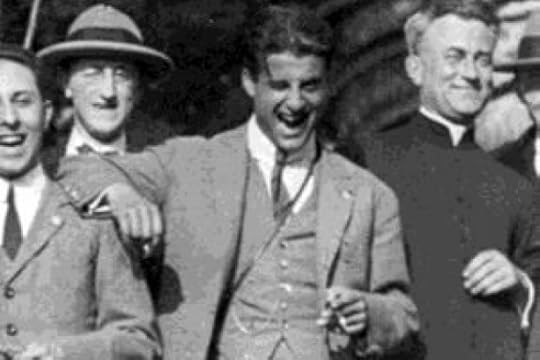
The post Pier Giorgio Frassati, Man of the Beatitudes: An Interview with Archbishop Peter Sartain appeared first on Brandon Vogt.





Brandon Vogt's Blog
- Brandon Vogt's profile
- 75 followers







